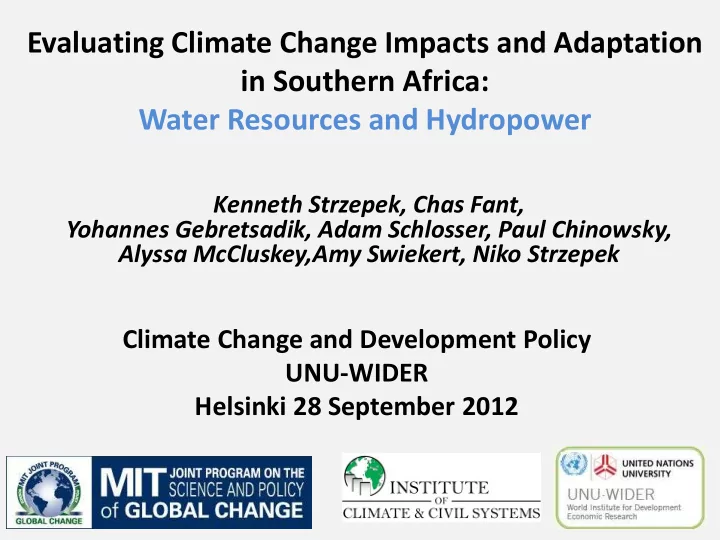

Evaluating Climate Change Impacts and Adaptation in Southern Africa: Water Resources and Hydropower Kenneth Strzepek, Chas Fant, Yohannes Gebretsadik, Adam Schlosser, Paul Chinowsky, Alyssa McCluskey,Amy Swiekert, Niko Strzepek Climate Change and Development Policy UNU-WIDER Helsinki 28 September 2012
A Classical Impact Assessment of Zambezi Assessment of the Impacts of Climate Change on Multi-Sector Investment Opportunities in the Zambezi River Basin TION PROJECTIONS ANNUAL AVERAGE HYDROPOWER GENERA BASELINE AGGREGATION-SPECIFIC PERCENT AVERAGE ANNUAL BASIN-WIDE PERCENT CHANGE CHANGE HYDROPOWER EARLY CENTURY MID CENTURY EARLY CENTURY MID CENTURY GENERATION (GW- AGGREGATION H) DRY WET DRY WET DRY WET DRY WET Upper Zambezi 8,565 -5% -2% -15% -2% -10% 1% -27% 1% Kafue River 9,528 -22% -3% -22% -4% -27% -8% -41% -3% Zambezi at Cahora Bassa 7,495 0% 0% -1% 0% -1% 0% -1% 0% Shire River 4,398 -11% 7% -16% 10% -9% 7% -18% 10% Lower Zambezi 4,095 0% 0% 0% 0% 0% 0% 0% 0% Zambezi River 34,082 -9% -1% -12% 0% -9% -1% -12% 0%
Existing Vulnerability Studies • Examine climate impacts via isolated transmission mechanisms – But impacts interact with each other (e.g., agriculture and rural roads) • Consider only a few un-weighted climate projections – Incomplete distribution of future climates – Uncertainty prevents standard investment risk analysis – Precautionary principle implies trade-offs with development spending • Shortcomings most severe for large-scale long-term investments – e.g., Hydropower, road infrastructure, agricultural research • Makes prioritizing adaptation investments extremely difficult – As a result, Planning Ministries are often reluctant to fully mainstream adaptation within national development strategies
Integrated Analytical Framework Global change (temperature, rainfall, fossil fuel prices) Rivers Sea level rise (runoff, streamflow) (land loss, salination) Flooding (frequency, severity) Infrastructure Energy Agriculture (roads, ports, houses) (hydropower) (food, exports) Local economy (growth, jobs, welfare, inequality)
Difficulty with Anticipating Climate Change • There is uncertainty about some aspects of regional climate change – Direction – Magnitude – Timing – Path
Changes in Mean Annual West Zambezi Runoff
Changes in Monthly Flooding East Zambezi
Changes in Monthly Flooding West Zambezi
Flooding Impact on Road Infrastructure STRESSOR-RESPONSE APPROACH BASE ON FREQUENCY OF WEATHER/FLOOD EVENT v. DESIGN STANDARD OF INFRASTRUCTURE Chinowsky
The Uncertain Future of Runoff in Zambezi River Zambia Zimbabwe
Impacts on Irrigation Demand in Mozambique • percent change averaged, 2046-2050 relative to 1980 - 2000
Zambezi River Development Plan
Impacts on Hydropower in 2050
Basin-wide Impacts on Hydropower in 2050 The Case for Regional Power Pools and Basin Cooperatipn
Flexible Design
Conclusion • No single answer for water related infrastructure • Flexible Design • Changes in Variability more important than MEANS • Makes sense to consider adaptations in risks context • NEED TO TAKE ECONOMY-WIDE MULTISECTOR APPROACH – Identify development priorities
Recommend
More recommend